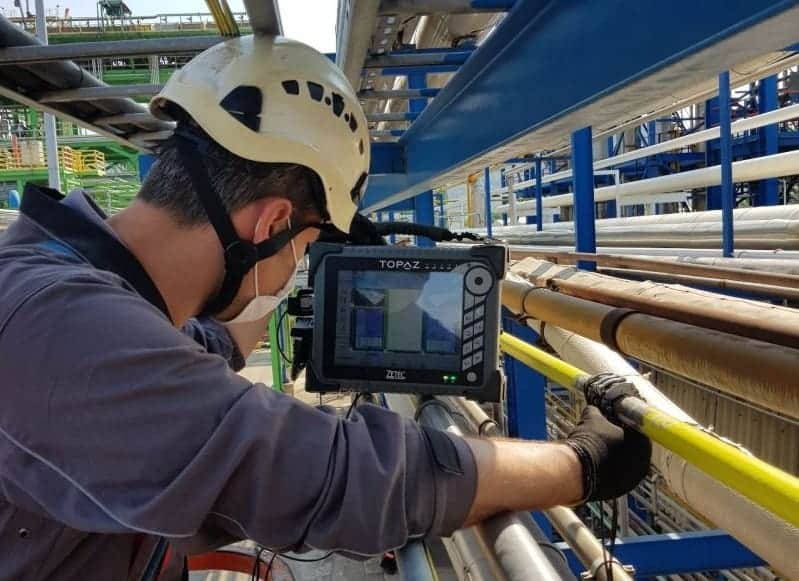Phased Array Ultrasonic Testing vs. Radiography: Advantages and Disadvantages
With a wide range of non-destructive testing (NDT) techniques available, industries have strived to make an ideal selection of inspection solutions that best meets their accuracy and precision requirements. In applications like weld testing, phased array ultrasonic testing (PAUT) and radiography have set new inspection benchmarks in their own way.
The unique capabilities of phased array ultrasonic and radiographic NDT provide distinct advantages in the identification of flaws such as cracks, corrosion, porosity, and inclusions. Here we will discuss how these NDT methods compare in terms of efficiency in flaw detection.
An Overview of Phased Array Ultrasonic and Radiographic NDT
The phased array ultrasonic testing method utilizes a multi-element probe, with each element having the ability to pulse individually at a controlled timing and sequence. The controlled sequence enables the optimization of angle, focus, and sweep of the beam. The reflected beam is then processed to create an image that can accurately identify any flaws or discontinuities in the material. This ultrasonic testing method has mostly gained popularity in industries for its effectiveness in determining material thickness, corrosion, or erosion in various types of complex geometrical components.
Radiographic inspection with X-rays or gamma rays has also been used in a similar context to identify surface or internal flaws for weld quality verification. A portable device with an X-ray generator transmits the beam to the material and the detecting device captures the beam reflected from the surface. The captured data is instrumental in assessing the discontinuities as well as properties like the size of the flaw and material thickness.
PAUT has emerged as a preferred NDT choice for many industries and has been slowly replacing radiography as the primary inspection technique. Thus, it is worth weighing the advantages and disadvantages when comparing phased array ultrasonic testing vs radiography methods to meet inspection standards.
The Benefits of Using Phased Array Ultrasonic Testing vs. Radiography
Safe Inspection
The foremost advantage that phased array ultrasonic testing provides in comparison to radiography is the safer inspection environment that it delivers. Radiographic testing can lead to exposure to potentially harmful rays. The operating personnel may also be required, depending on environmental standards, to vacate the facility while radiographic testing is in progress.
The use of simple ultrasonic waves does not possess any environmental or safety hazards and technicians and operators can continue the NDT process without any risks of harmful exposures.
Inspection Reliability
Radiographic inspection relies on many factors to deliver accurate inspection results, one of them being the orientation of the flaw with respect to the radiation beam. The X-rays analyze cracks as a thickness variation. When a crack is parallel to the path of the X-ray, it is difficult for the beam to sense the change in thickness. Thus, some flaws may remain undetected.
Phased array ultrasonic testing offers the ability to focus and steer the beam at different angles. This provides complete coverage and fosters the probability of flaw detection along different orientations, thus, increasing the reliability of inspection.
Speed
Phased array ultrasonic inspection utilizes multiple transducers for inspection which results in a much faster scanning of the material.
In contrast, the radiographic method of inspection is much slower. Not only does it need the extra procedure of permits and clearance to perform, even after the image capture, there is also an elaborate process of negative development. This resulting monochromatic radiograph can also be a slow process to interpret for untrained eyes.
Inspection Complexity
Radiographic testing provides a benefit of applicability with a wide range of materials and assessment with a minimal amount of surface preparation. And, depending upon the orientation of the flaw, it also provides the ability to inspect and develop images for complex mechanical assemblies and hidden areas, thus reducing the complexity of the inspection.
PAUT also facilitates the identification of flaws in areas that are hidden from the probes in complex geometrical structures. But, its advanced steer and focus technique can allow flaws to be identified faster.
Phased Array Ultrasonic Testing vs. Radiography: Which is the Better Choice?
Phased array is being used as an alternative to radiographic testing in industries including aerospace, oil, and gas, or power generation for the inspection of welds or planar flaws. As productivity and quality become the goal for industries, flexibility, reliability, safety, accuracy, and speed become major defining factors in the choice of NDT technology. In the choice between phased array ultrasonic testing vs. radiographic NDT, it is safe to conclude that the advantages of PAUT outweigh those of radiographic testing.
Zetec has been a leading provider of phased array ultrasound testing solutions to quickly and accurately detect flaws. To learn more about the latest PAUT products and innovations, contact Zetec today.

Zetec’s designers are industry-leading experts in ultrasonic and eddy current technologies, and we can help you navigate any of our NDT testing solutions or devices.

